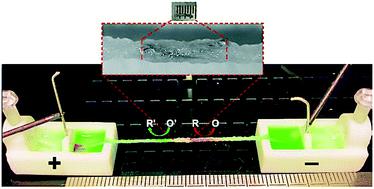Our official English website, www.x-mol.net, welcomes your
feedback! (Note: you will need to create a separate account there.)
Wireless bipolar electrode-based textile electrofluidics: towards novel micro-total-analysis systems
Lab on a Chip ( IF 6.1 ) Pub Date : 2021-08-26 , DOI: 10.1039/d1lc00538c Jawairia Umar Khan 1, 2 , Andres Ruland 1 , Sepidar Sayyar 1, 3 , Brett Paull 4 , Jun Chen 1 , Peter C Innis 1, 3
Lab on a Chip ( IF 6.1 ) Pub Date : 2021-08-26 , DOI: 10.1039/d1lc00538c Jawairia Umar Khan 1, 2 , Andres Ruland 1 , Sepidar Sayyar 1, 3 , Brett Paull 4 , Jun Chen 1 , Peter C Innis 1, 3
Affiliation

|
Point of care testing using micro-total-analysis systems (μTAS) is critical to emergent healthcare devices with rapid and robust responses. However, two major barriers to the success of this approach are the prohibitive cost of microchip fabrication and poor sensitivity due to small sample volumes in a microfluidic format. Here, we aimed to replace the complex microchip format with a low-cost textile substrate with inherently built microchannels using the fibers' spaces. Secondly, by integrating this textile-based microfluidics with electrophoresis and wireless bipolar electrochemistry, we can significantly improve solute detection by focusing and concentrating the analytes of interest. Herein, we demonstrated that an in situ metal electrode simply inserted inside the textile-based electrophoretic system can act as a wireless bipolar electrode (BPE) that generates localized electric field and pH gradients adjacent to the BPE and extended along the length of the textile construct. As a result, charged analytes were not only separated electrophoretically but also focused where their electrophoretic migration and counter flow (EOF) balances due to redox reactions proceeding at the BPE edges. The developed wireless redox focusing technique on textile constructs was shown to achieve a 242-fold enrichment of anionically charged solute over an extended time of 3000 s. These findings suggest a simple route that achieves separation and analyte focusing on low-cost surface-accessible inverted substrates, which is far simpler than the more complex ITP on conventional closed and inaccessible capillary channels.
中文翻译:

基于无线双极电极的纺织电流体:迈向新型微全分析系统
使用微型全分析系统 (μTAS) 进行即时检测对于具有快速和稳健响应的紧急医疗保健设备至关重要。然而,这种方法成功的两个主要障碍是微芯片制造成本过高,以及由于微流体格式的样本量小而导致的灵敏度差。在这里,我们的目标是用低成本的纺织基材取代复杂的微芯片格式,该基材具有使用纤维空间固有的微通道。其次,通过将这种基于纺织品的微流体与电泳和无线双极电化学相结合,我们可以通过聚焦和浓缩感兴趣的分析物来显着改善溶质检测。在这里,我们证明了原位简单地插入基于纺织品的电泳系统内的金属电极可以充当无线双极电极 (BPE),它在 BPE 附近产生局部电场和 pH 梯度,并沿着纺织品结构的长度延伸。结果,带电分析物不仅通过电泳分离,而且还集中在它们的电泳迁移和逆流 (EOF) 平衡处,因为氧化还原反应在 BPE 边缘进行。研究表明,针对纺织品结构开发的无线氧化还原聚焦技术可在 3000 秒的延长时间内使带阴离子电荷的溶质富集 242 倍。这些发现提出了一种实现分离和分析物的简单途径,专注于低成本的表面可接近的倒置底物,
更新日期:2021-09-02
中文翻译:

基于无线双极电极的纺织电流体:迈向新型微全分析系统
使用微型全分析系统 (μTAS) 进行即时检测对于具有快速和稳健响应的紧急医疗保健设备至关重要。然而,这种方法成功的两个主要障碍是微芯片制造成本过高,以及由于微流体格式的样本量小而导致的灵敏度差。在这里,我们的目标是用低成本的纺织基材取代复杂的微芯片格式,该基材具有使用纤维空间固有的微通道。其次,通过将这种基于纺织品的微流体与电泳和无线双极电化学相结合,我们可以通过聚焦和浓缩感兴趣的分析物来显着改善溶质检测。在这里,我们证明了原位简单地插入基于纺织品的电泳系统内的金属电极可以充当无线双极电极 (BPE),它在 BPE 附近产生局部电场和 pH 梯度,并沿着纺织品结构的长度延伸。结果,带电分析物不仅通过电泳分离,而且还集中在它们的电泳迁移和逆流 (EOF) 平衡处,因为氧化还原反应在 BPE 边缘进行。研究表明,针对纺织品结构开发的无线氧化还原聚焦技术可在 3000 秒的延长时间内使带阴离子电荷的溶质富集 242 倍。这些发现提出了一种实现分离和分析物的简单途径,专注于低成本的表面可接近的倒置底物,











































 京公网安备 11010802027423号
京公网安备 11010802027423号